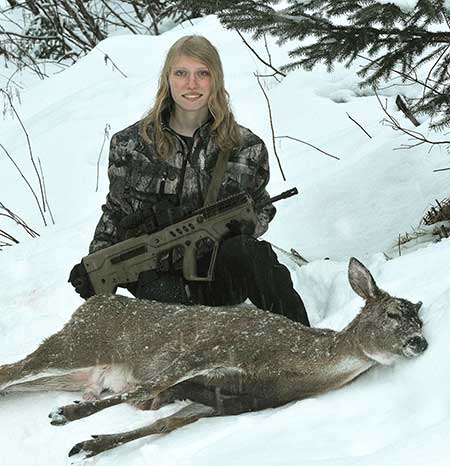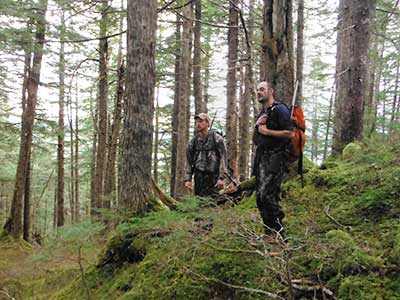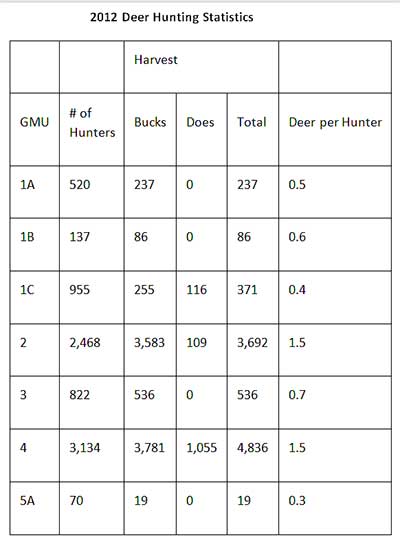Alaska Fish & Wildlife News
August 2014
Deer Hunting Forecast and “State of the Deer”

Sitka black-tailed deer season opened Aug. 1 in most of Alaska. There are vast differences in deer numbers across their range in Alaska. Past winters hammered deer in many areas and populations are still recovering, but last winter was relatively mild and survival was good. Fish and Game biologists offer their insights into the areas they manage.
Sitka black-tailed deer are found throughout Southeast Alaska and have been introduced to Prince William Sound and Kodiak Island. Southeast is divided into five Game Management Units, managed by area biologists.
These state biologists gather information on deer in a variety of ways. A report card associated with each set of harvest tickets is filled out by hunters and returned, and provides insights into hunter success and possible trends. Biologists spend time in the field looking at deer, deer sign and the condition of the habitat. They talk with hunters and others who spend time afield. Deer pellet transects are conducted in the spring in specific watersheds, providing insights into trends. Mortality surveys are done in some areas to asses winterkill. Aerial surveys of the alpine in some places offer clues. In central Southeast, biologists are experimenting with a new mark-recapture technique involving DNA analysis of deer pellets that may help measure abundance and changes in abundance.
The ABC Islands and Prince of Wales
State wildlife biologist Phil Mooney manages deer (in GMU 4) on the ABC islands, Admiralty, Baranof, Chichagof, areas popular with hunters. Deer numbers plummeted on the islands after the winters of 2006-07 and ’07-’08, when deep snow persisted late into spring. The northern and eastern sides of the islands were particularly hard hit. Deer numbers have improved in recent years.
“Unit Four is looking good,” Mooney said. “We’re seeing lots of twin fawns. The report from northeast Chichagof is lots of fawns, the population is definitely up.”
The doe harvest was curtailed on northeast Chichagof in past years due to low numbers, but Mooney said he doesn’t see the need for any hunting restrictions there this fall.
“We had very little, if any, winterkill,” he said.
“Last fall was mild and deer stayed high, so hunters working the beaches and sea level areas weren’t seeing the easy ones,” Mooney said. “They were up in the woods, and people reported seeing deer at 3,000 feet in October.”
Mooney said a deer research project is underway in the Sitka area, and he’s been collaring deer. It’s a cooperative venture between the Forest Service, ADF&G, and the Sitka Conservation Society, looking at the use of second growth forest by deer. Researchers are looking at the habitat as well as the deer, and Mooney said he’s targeting 10 deer and some of those will wear GPS-Iridium-linked tracking collars. The device is new and offers a remarkable feature over the store-on-board collars that must be retrieved to download the data.
“It dials your phone every two weeks or so and downloads the data,” Mooney said.
Past research has offered some good insights into deer, and Mooney mentioned a joint ADF&G and graduate student research project on Prince of Wales Island that provides a sense for how much habitat a Sitka black-tailed deer needs, and what deer densities are in good years in good habitat. Mooney said that work indicates 18 to 22 deer per square mile. That’s about one deer per 22 to 35 acres (there are 640 acres in a square mile). A NFL football field is 160’ x 360’ feet or 1.3 acres.

“An area encompassing 22 to 27 football fields is about the area needed to support a deer, and that’s good habitat with forage for winter and summer, with a mix of canopy cover and open areas,” Mooney said.
Deer numbers are looking good on Prince of Wales this year. Steve Bethune is a state wildlife biologist based in Craig on Prince of Wales Island.
“I believe we’re going to have a good year,” he said. “We’ve had two consecutive mild winters and we’re seeing lots of deer out there, seeing a lot of both last years’ and new fawns. The deer appear to be in good shape. That’s in the central, roaded portion of the island. Typically deer density is lower on the northern end, it gets more snowfall, but it also gets less hunting pressure.”
The southern end of POW has lower habitat productivity and consequently lower deer densities.
The deer are having an effect on their current winter forage. “I am a little concerned about the existing winter habitat, I’m seeing high browsing levels in some areas,” Bethune said. “If we had a rough snowy winter it could impact the Unit 2 deer herd significantly.”
Bethune is an avid hunter himself. “Personally I’m looking forward to the season. I anticipate there’s going to be some high quality bucks. I’m praying for good weather, that’s always the kicker for hunting opportunities.”
The Southeast Mainland
Ketchikan is east of Prince of Wales, and Unit 1A includes the Ketchikan area and the mainland of southern Southeast. Boyd Porter is the state biologist there, and he said the recent mild winters have been good for the local deer in his area.
“It’s looking as good as it’s been in 15 years,” he said. “Numbers in 1A are still not what we’d consider high, compared to POW, but high relative to other years in this same unit.”
Recruitment of last year’s fawns is good, and many does survived the past winter in good shape. “The young and old are typically the first to go in a severe winter, and we’re seeing lots of last year’s fawns – indicating they survived the winter and lots of new twins which suggests the females went into winter in good condition and gave birth to twin fawns.”
Porter said conversely, in a tough winter, a pregnant doe may reabsorb the small fetus, a physiological strategy that allows her to preserve the otherwise additional energy investment. The doe may also lose one or both fawns to starvation related causes during a hard winter and we did not see much sign this past year of winter fawn loses.
He said deer numbers are slowly coming up on Gravina Island, but are still very low on both Gravina Island the Cleveland Peninsula.
“We are still looking closely at the Cleveland and Gravina Island to measure changes in deer populations and indications of recovery. For these areas you’ve got these little pockets of deer,” he said. “Even though a few watersheds may be increasing in these two areas, they’re not dispersing and filling in some of the gaps.” Research in Southeast Alaska shows that a Sitka black-tailed deer tends to live its entire life in the area where it was born, usually the specific watershed.
“In general, if you have sufficient habitat, and predation is moderate or low, deer can reproduce and rebound rapidly,” Porter said. “But they don’t necessarily radiate out in other areas, they don’t replenish the whole landscape with deer. There are all kinds of reasons for a deer to stay in its home range: it knows where bedding areas are, the best areas to find food, safe movement corridors, and females know where they’ve safely given birth and raised fawns.”

Biologists are currently working on new monitoring methods to estimate deer densities and to better track changes in deer populations in southern southeast.
Deer are found in pockets along the Southeast mainland between the Cleveland Peninsula and the Stikine River. Rich Lowell, based in Petersburg, is the biologist for this area and islands to the west, including Mitkof, Woewodski and Kupreanof Islands. He said numbers are down.
“If anybody is thinking about coming to Unit 3 to hunt deer, they should seriously reconsider,” Lowell said. “We had die-offs associated with record snowfall in 2006, followed by three consecutive winters with above average snowfall. On top of those hard winters, there’s predation by wolves and black bears.”
The low numbers are reflected in the regulations. “Portions of Unit 3 are managed under the most restrictive seasons and bag limits in Southeast Alaska,” Lowell said, “including Mitkof, Woewodski Islands and the Lindenberg Peninsula on Kupreanof Island.”
There is one bright spot that offers some hope for coming years. “The past winter we had below average snowfall, about 50 percent of normal, which may aid in rebuilding the population,” Lowell said.
Moving up the coast to the Juneau area, state wildlife biologist Ryan Scott echoed others’ sentiments about the benefit of the recent mild winter.
“I think deer did pretty well last year,” he said. “Seeing twins is a good indication of a healthy deer population. As far as deer pellets go, it appears that pellet counts were average or just below average. I anticipated we’d see more, but because of the mild winter, deer may have been much more distributed than they would be in a winter with heavy snow where they are more concentrated.”
Consistent with the rest of Southeast Alaska, deer numbers on the northern mainland are lower than the islands to the west. For a lot of Juneau hunters, that’s Douglas Island and Admiralty Island. Scott said deer numbers look good.
“My overall impression is Douglas is a good opportunity to hunt,” he said. “I think it’s going to be a good season.”
Also a hunter, Scott was encouraged by what he saw last fall. “We saw more sign last year when we were deer hunting on northern Admiralty than we have in years,” he added.
Scott said the habitat is in good shape in northern Southeast. “One positive outcome to having low deer density for a few years is that you give the vegetation time to regenerate,” he said.
The Yakutat area, Unit 5A, has an extremely limited deer season for Alaska standards, because deer numbers are low. “It’s a difficult place to make a living for a deer,” Scott said. “It gets a lot of snow and that keeps the numbers down. That is a one month season, November first to December first, with a one buck bag limit.”
Prince William Sound
Historically, Sitka black-tailed deer were not found north and west of Yakutat, that’s the extreme northern limit of their natural range. Deer from the Sitka area were introduced to Kodiak and adjacent islands in the 1920s and ‘30s, and deer were introduced to Prince William Sound and area islands between 1916 and 1923. They tend to do better on the islands (like Hinchinbrook and Hawkins) than on the mainland, because the maritime climate is a bit milder. However, winter mortality can be severe, and it seems that every decade a winter comes along that hammers the population. In the winter of 2011-12, more than 27 feet of snow was recorded in Cordova.

Charlotte Westing is the biologist based in Cordova. She manages deer in the Prince William Sound area.
“Our deer population took a huge hit in the snowpocalypse of 2011-12,” Westing said. “Harvest was high in 2011-12, because snow was concentrating deer on the beaches, and people knew there’d be a lot of winter kill. That was compensatory, because so many animals were going to starve. The next year was an unbelievably low harvest.”
That was reflected in the pellet transects, and the lowest count on record was observed. This year numbers were up, but it was still the second-lowest count on record. “This year we went back and there were more pellets, an improvement over the previous year, but still low. Last winter was mild, and there were fewer hunters, because people knew numbers were down. Hunters were more successful and they reported that (deer) body condition was good.”
Last year the doe season closed at end of October, Westing said. “We wanted to leave does in the population and allow the population to rebuild faster.”
Right now she has no plans for special measures. “But if we get a big snow deposition I’ll consider an early doe closure, recognizing that the population is still low. People are excited that it’s getting better, but it’s still not very good.”
Kodiak Island
Kodiak Island and adjacent Afognak Island were also hard hit by the winter of 2011-12, with an estimated 40 percent mortality, but state biologist Nate Svoboda said deer are coming back.
“It’s a pretty big deal for everyone here,” he said. “Last year they recovered well, particularly on Afognak and the southern portion of the island. This year we had a mild winter and a really early spring, and it's been a perfect summer, particularly for the wildlife population.”
He said reports from the public, from guides, observations by staff, and surveys of the Aliulik Peninsula and on Afognak Island indicate that deer are fat and happy. “They’re recovering really well,” he said. “I think it’s going to be a really good year for deer hunting.”
Targeted mortality surveys are conducted in the spring on Kodiak, before the bears emerge, and biologists look at winter kill. “We do them in historical overwintering areas, where deer congregate to find food. It gives a snapshot picture. This spring there were very few dead deer. There were really high numbers after that harsh winter of 2011 and 12.”
“Deer on Kodiak are regulated more by the weather than anything else,” he added. “That’s the limiting factor.”
For more information on the deer transplants to Prince William Sound and Kodiak Island, see Game Transplants in Alaska.
Subscribe to be notified about new issues
Receive a monthly notice about new issues and articles.
